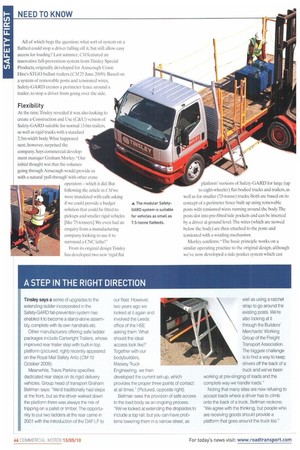A STEP IN THE RIGHT DIRECTION
Page 46

If you've noticed an error in this article please click here to report it so we can fix it.
Tinsley says a series of upgrades to the extendIng ladder incorporated in the Safety-GARD fat-prevention system has enabled it to become a stand-alone assembly, complete with its own handrails etc.
Other manufacturers offering safe ladder packages include Cartwright Trailers, whose improved rear trailer step with built-in top platform (pictured, right) recently appeared on the Royal Mail Safety Artic (CM 10 October 2009).
Meanwhile, Travis Perkins specifies dedicated rear steps on its rigid delivery vehicles. Group head of transport Graham Bellman says: "We'd traditionally had steps at the front, but as the driver walked down the platform there was always the risk of tripping on a pallet or timber. The opportunity to put two ladders at the rear came in 2001 with the introduction of the DAF LF to
our fleet. However, two years ago we looked at it again and involved the Leeds office of the HSE asking them 'What should the ideal access look like?' Together with our bodybuilders, Massey Truck Engineering, we then developed the current set-up, which provides the proper three points of contact at all times." (Pictured, opposite right).
Bellman sees the provision of safe access to the load body as an ongoing process. "We've looked at extending the dropsides to include a top rail, but you can have problems towering them in a narrow street, as well as using a ratchet strap to go around the existing posts. We're also looking at it through the Builders' Merchants' Working Group of the Freight Transport Association. The biggest challenge is to find a way to keep drivers off the back of a truck and we've been working at pre-slinging of loads and the complete way we handle loads."
Noting that many sites are now refusing to accept loads where a driver has to climb onto the back of a truck, Bellman reckons: "We agree with the thinking, but people who are receiving goods should provide a platform that goes around the truck too."
































































































































